Have you ever been curious about what wild boar tastes like? You’re not alone.
For those looking to diversify their dinner plate, this article provides an overview of wild boar’s flavors, best cooking approaches, and recommended tips for preparing it.
So, let’s dive into the secrets behind this wild-foraged food.
What is Wild Boar?

Wild boar is a type of pig that is not domesticated and lives in the wild.
It can be found in different parts of the world, including Europe, Asia, and North Africa.
While discussing the characteristics and texture of wild boar meat, it is necessary to ignore the flavor as the flavor of wild boar meat is subjective and can vary depending on various factors such as age, diet, and gender.
Wild boar meat is often leaner than regular pork, which contributes to its firmer texture and darker color.
It has a distinct gamey flavor that some people compare to venison or grass-fed beef.
Wild boar meat is also a good source of protein, niacin, selenium, and other essential nutrients.
When it comes to cooking wild boar meat, it is vital to cook it thoroughly to prevent the risk of infection since wild boars may carry diseases such as Hepatitis E and Trichinella.
It is essential to cook wild boar meat until its internal temperature reaches 160°F.
This meat can be roasted, slow-cooked, or grilled according to your preference.
Eating wild boar meat is not only delicious but also healthy in moderation.
If you have a taste for gamey meat, you may find wild boar to be a great alternative to other meats.
However, it is always wise to consult your doctor before including any new food in your diet.
What Does Wild Boar Taste Like?
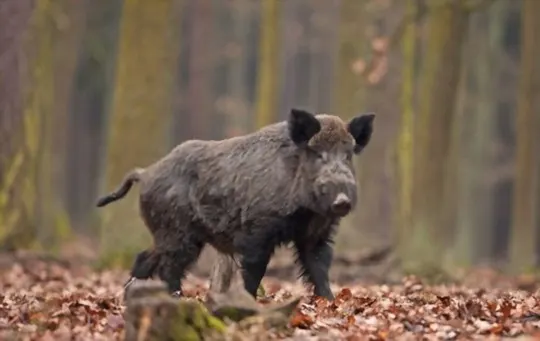
Wild boar meat is often described as having a unique and rich flavor that sets it apart from traditional pork.
However, the taste of wild boar can vary depending on the age, diet, and living environment of the animal.
Generally, wild boar meat is leaner and denser than pork, with a darker red color and a gamey flavor that can range from mild to intense.
The meat can also have a slightly nutty taste, with hints of sweetness and a smoky aftertaste.
Here are some additional factors that can affect the taste of wild boar meat:
- Age: Younger wild boars have tender and mild-tasting meat, while older animals have tougher and stronger-tasting meat.
- Diet: Wild boars that have foraged on nuts, berries, and herbs may have a sweeter and more complex flavor, while those that have eaten mostly grain and processed feed may have a blander taste.
- Preparation: Properly seasoning and cooking wild boar meat can enhance its flavor and tenderize its texture, while inadequate heating or overcooking can make the meat tough and gamey.
Wild boar meat is a healthy and sustainable alternative to conventional pork, with a high protein content and lower fat and cholesterol levels.
If you’re interested in trying this unique meat, look for local and organic sources and experiment with different recipes and cooking techniques.
Pro tip- Pair wild boar meat with bold flavors like garlic, mustard, and rosemary to complement its rich taste.
Factors that Affect the Taste of Wild Boar
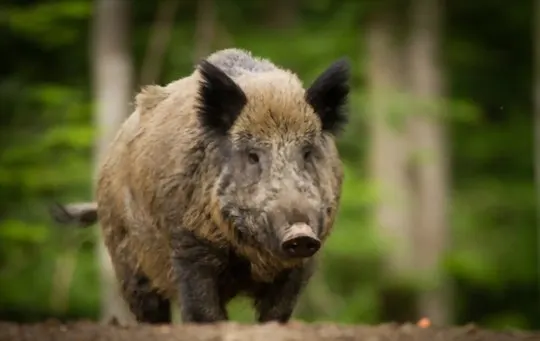
Wild boar meat has a distinctive and robust flavor that sets it apart from other types of meat.
Here are the factors that affect the taste of wild boar:
- Diet: Wild boars have a varied diet that includes roots, tubers, nuts, berries, and other forest vegetation. The flavor of the meat depends on the type of food the animal eats.
- Age: The age of the animal also impacts the flavor of the meat. Older boars have a stronger taste than younger ones.
- Gender: Male wild boars, or boars, have a muskier flavor than female ones, or sows, due to hormone differences.
- Environment: The environment in which a wild boar lives also affects the taste of the meat. Boars that live in agricultural areas or near dumpsites may have a different flavor than those that live in the wild.
- Cooking Method: How you cook wild boar can greatly impact its taste. Slow-cooking methods can help to mellow out the strong flavor, while marinades and seasonings can add dimension and complexity to the meat.
Proper preparation and cooking of wild boar meat can lead to a delicious and unique culinary experience.
Pro Tip: Before cooking wild boar meat, soak it in acidulated water (water with vinegar or lemon juice) for a few hours to help reduce its gamey taste.
1 – Diet and Habitat
What a wild boar eats and where it lives heavily influence its flavor, making it hard to pinpoint a specific taste.
Wild boar meat is leaner and darker than pork, but its taste can vary depending on several factors.
- Diet: Wild boars forage for their food, so their diet can include acorns, nuts, and roots. This gives the meat a nutty, earthy flavor. In contrast, farmed boars are often fed a diet of corn, which can produce a milder, sweeter meat.
- Habitat: Wild boars live in a variety of terrains, from forests to grasslands to wetlands. This can impact the animal’s muscle tone, which can affect the meat’s texture and flavor.
- Age: Older wild boars have tougher meat and stronger flavors, while younger ones have tender meat and milder flavors.
- Preparation: Due to its leanness and strong flavor, wild boar meat benefits from marination and slow cooking methods like roasting or braising. It can also be ground or used in stews and sausages.
Ultimately, the taste of wild boar meat can be described as rich, gamey, and with a hint of sweetness, but its unique taste is hard to accurately describe.
2 – Age and Gender
Age and gender are two factors that can affect the taste of wild boar meat.
Generally, young boars or sows are recommended for better taste and tenderness, while older boars may have a more “gamey” flavor due to their hormones and tougher meat.
Here are some more details you need to know about the taste of wild boar meat.
- Flavor profile: Wild boar meat has a rich, intense, and slightly sweet flavor. It is leaner and denser than pork, with a texture similar to beef, and often has a smokier taste due to the animal’s foraging diet.
- Preparation tips: Wild boar meat should be cooked low and slow to preserve its tenderness and moisture. It pairs well with bold and tangy flavors like garlic, red wine, and rosemary.
- Nutritional value: Wild boar meat is high in protein, low in fat, and contains more iron and vitamins than pork, making it a healthier alternative.
Pro tip: Before cooking, marinate the wild boar meat for a few hours to tenderize it and impart additional flavors.
3 – Cooking Method
Wild boar is a delicious and flavorful meat that is leaner than conventional pork.
There are various methods to cook wild boar, each enhancing its unique taste and texture.
- Roasting: Roasting is the best method for larger cuts of wild boar, such as a leg or shoulder. It’s a slow cooking process that allows the meat to retain its moisture and tenderness while developing a crispy exterior.
- Grilling: Grilling is a quick and easy way to cook wild boar steaks or chops. Just like pork, be sure not to overcook it, as it can dry out quickly. Marinating the meat beforehand can help to enhance its flavor and tenderness.
- Braising: Braising is a long, slow cooking method that involves searing the meat and then cooking it in a liquid, such as red wine or stock. This method is perfect for tougher cuts of wild boar, such as the shoulder or shank.
- Stir-fry: Stir-frying is a quick and easy way to cook wild boar strips or cubes. This method works well with marinated meat and allows you to incorporate a variety of vegetables and flavors for a delicious and healthy meal.
Pro tip: Wild boar has a stronger, gamier flavor than conventional pork, so it’s important to pair it with bold flavors and seasonings.
Try incorporating garlic, rosemary, thyme, or mustard for added depth of flavor.
How to Cook Wild Boar to Enhance its Flavor?
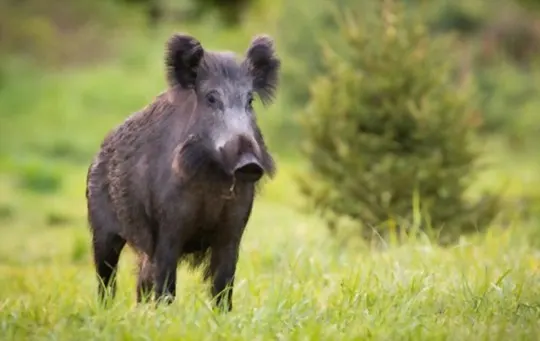
Wild boar has a distinctive flavor that is leaner, gamier, and richer than traditional pork.
Cooking wild boar correctly can enhance its natural flavors, resulting in a delicious and tender meat.
Here are some tips to follow when cooking wild boar:
Marinate the meat overnight in acidic ingredients like wine, vinegar, or citrus juices.
This helps tenderize and infuse flavors into the meat.
Wild boar has a low-fat content, so it’s important not to overcook it, or it will become tough and dry.
Use low-temperature cooking methods like slow roasting, braising, or smoking to preserve the moisture and flavor of the meat.
Season the meat with bold combinations of herbs and spices like rosemary, sage, black pepper, and juniper berries to complement its gamy flavor.
Serve the cooked wild boar hot, and let it rest for a few minutes to allow the juices to redistribute.
With these tips, you can cook wild boar into a flavorful and tender meat that is sure to impress your dinner guests.
Is Wild Boar Healthy?
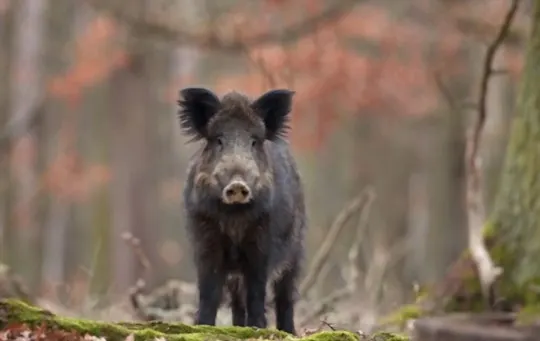
Wild boar is not only a unique and flavorful meat, but it is also a healthier alternative to traditional meats.
Wild boar is leaner than pork and contains less saturated fat and calories while providing more protein and essential nutrients such as iron and zinc.
Taste-wise, wild boar has a distinctive flavor that is richer, bolder, and sweeter than pork.
Its texture is slightly coarser and firmer than pork, making it perfect for slow-cooked dishes such as stews or roasts.
However, it is essential to note that wild boar meat can carry harmful bacteria due to its wild nature, so it is crucial to ensure that the meat is thoroughly cooked before consumption.
Pro tip: Marinating the wild boar meat before cooking can help tenderize it and enhance its flavor.
Where to Buy Wild Boar Meat and How to Store It
Wild boar meat is becoming increasingly popular among food enthusiasts and meat lovers; however, it can be challenging to find in regular grocery stores.
Here are some great places to buy wild boar meat, along with storage tips to keep it fresh.
Where to Buy Wild Boar Meat:
- Specialty meat markets: Look for specialty meat markets that offer a wide range of exotic meats, including wild boar.
- Online retailers: Several online retailers specialize in selling wild boar meat and other game meats. Ensure you buy from reputable retailers to ensure quality and freshness.
- Local farms: You can also reach out to local farms and hunters in your area that may offer wild boar meat.
Storing Wild Boar Meat:
- Fresh wild boar meat can be kept in the refrigerator for up to four days.
- Wrap the meat tightly in plastic wrap or aluminum foil and store it at the bottom of the fridge.
- You can freeze wild boar meat for up to six months. Ensure that the meat is tightly wrapped in freezer-safe packaging to prevent freezer burn.
- Cooked wild boar meat can be refrigerated for up to four days and frozen for up to six months.
Pro tip: Before cooking wild boar meat, marinate it overnight in acidic ingredients like wine, vinegar, or citrus juice to help tenderize the meat and add flavor.
Conclusion
In conclusion, wild boar meat offers a flavorful and unique taste that is unlike any other type of meat.
Its lean nature and rich flavor profile make it a versatile ingredient for various dishes, from stews to sausages.
However, it’s important to note that the taste of wild boar meat can vary depending on the animal’s diet and age, as well as the cooking method used.
Some of the common taste characteristics of wild boar meat include a stronger and richer flavor than pork, with a slightly nutty taste and a firm texture.
When cooking wild boar meat, it is advisable to marinate it for a while before cooking to enhance its taste and texture.
In addition, it’s important to ensure that it’s cooked thoroughly to kill any harmful bacteria that may be present.
All in all, wild boar meat is a tasty and nutritious alternative to pork, and trying it out can be a fun and exciting culinary adventure.
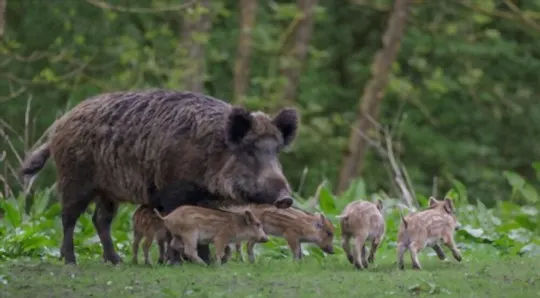
What Does Wild Boar Taste Like? A Comprehensive Guide
Ingredients
- Wild boar
- Ingredients from your selected recipes
Instructions
- Select your favorite ingredient from the range available in this article.
- Collect all the necessary items to make the recipe.
- Use the instructions provided to prepare a delicious dish in 30 minutes or less.

Carrie is a food writer and editor with more than 15 years of experience. She has worked for some of the biggest names in the food industry, including Bon Appétit, Food & Wine, and Martha Stewart Living.
As the Editor in Chief of IntroChicago.com, Carrie oversees all of the content on the site. She also manages the team of contributing writers and editors, who help to create delicious recipes, helpful tips, and informative articles that you’ll find on the site.
A native of the Chicago area, Carrie is passionate about all things food. She loves trying new restaurants and experimenting with new recipes in her kitchen. She’s also a graduate of the Culinary Institute of America, so she knows a thing or two about food!
